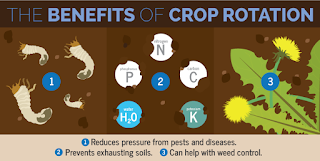Crop rotation increase the soil fertility and prevent the soil
erosion
Crop rotation is the systematic planting of different crops in a particular order over several years in the same growing space. This process helps maintain nutrients in the soil such as three main nutrients are nitrogen,phosphorus potassium(NPK), reduce soil erosion, and prevents plant diseases and pests. Other important nutrients are calcium,magnesium and sulfur. The length of rotation time between different plants will also vary depending on the needs of the gardener.
Figure 2: soil erosion
Soil organic matter and clay particles hold large stores of plant nutrients. These reservoirs, however, are not all available to the crop. Some of these nutrients leave the farm as harvested products, and the rest return to the soil as crop residues. Crop roots and residues improve soil fertility by stimulating soil microbial communities and improving soil aggregation. This improved soil physical environment facilitates water infiltration, water holding, aeration, and, ultimately, root growth and plant nutrient foraging. This section will review different ways that crop rotations affect soil fertility. However, crop rotation can significantly reduce the amount of soil lost from erosion by water. In areas that are highly susceptible to erosion, farm management practices such as zero and reduced tillage can be supplemented with specific crop rotation methods to reduce raindrop impact, sediment detachment, sediment transport, surface run off, and soil loss. Besides that,Protection against soil loss is maximized with rotation methods that leave the greatest mass of crop stubble on top of the soil. Stubble cover in contact with the soil minimizes erosion from water by reducing overland flow velocity, stream power, and thus the ability of the water to detach and transport sediment. Before that,The formation of soil aggregates is important for erosion control, as they are better able to resist raindrop impact, and water erosion. Soil aggregates also reduce wind erosion, because they are larger particles, and are more resistant to abrasion through tillage practices.
figure 3: water in soil
figure 4: plant
prepared by:
Muhammad Faiz Bin Zulkifli (2018201186)
References:
 1)https://ec.europa.eu/jrc/en/news/soil-erosion-costs-european-farmers-125-billion-year
1)https://ec.europa.eu/jrc/en/news/soil-erosion-costs-european-farmers-125-billion-year
2)https://www.maximumyield.com/definition/317/crop-rotation
3)https://www.fruithillfarm.com/info/2017/02/crop-rotation/
4)https://www.sare.org/Learning-Center/Books/Crop-Rotation-on-Organic-Farms/Text-Version/Physical-and-Biological-Processes-In-Crop-Production/Crop-Rotation-Effects-on-Soil-Fertility-and-Plant-Nutrition







“Benjamin Briel Lee was very professional at all times, keeping me aware of everything that was happening, If I had any questions he was always available to answer. This was my first home purchase, I didn’t know much about the loan process, he made it very easy to understand the things I had questions about. I really enjoyed working with him.”
ReplyDeleteHe's a loan officer working with a group of investor's who are willing to fund any project or loan you any amount with a very low interest.Contact Benjamin Briel Lee E-Mail: lfdsloans@outlook.comWhats-App Number: +1-989-394-3740.